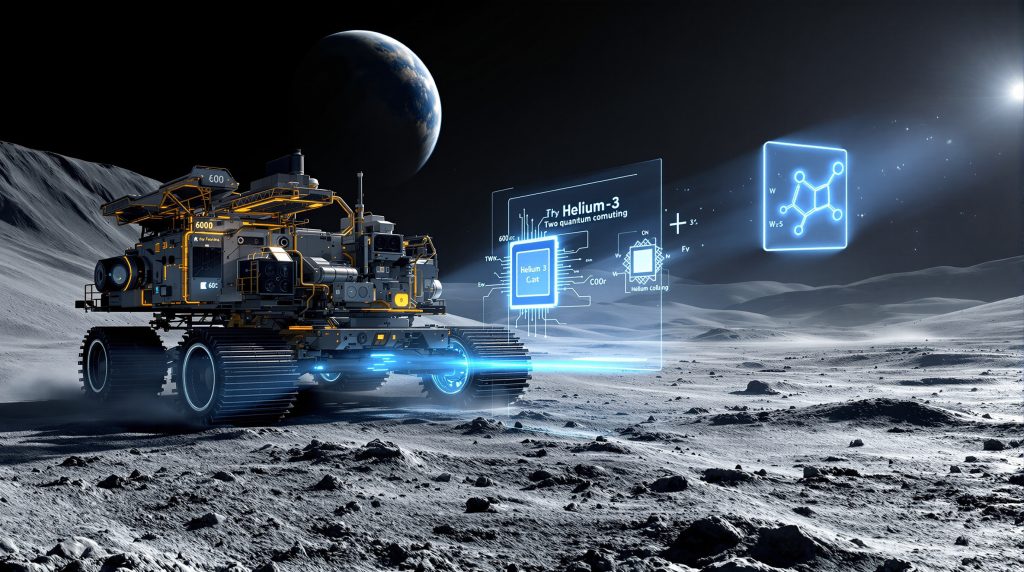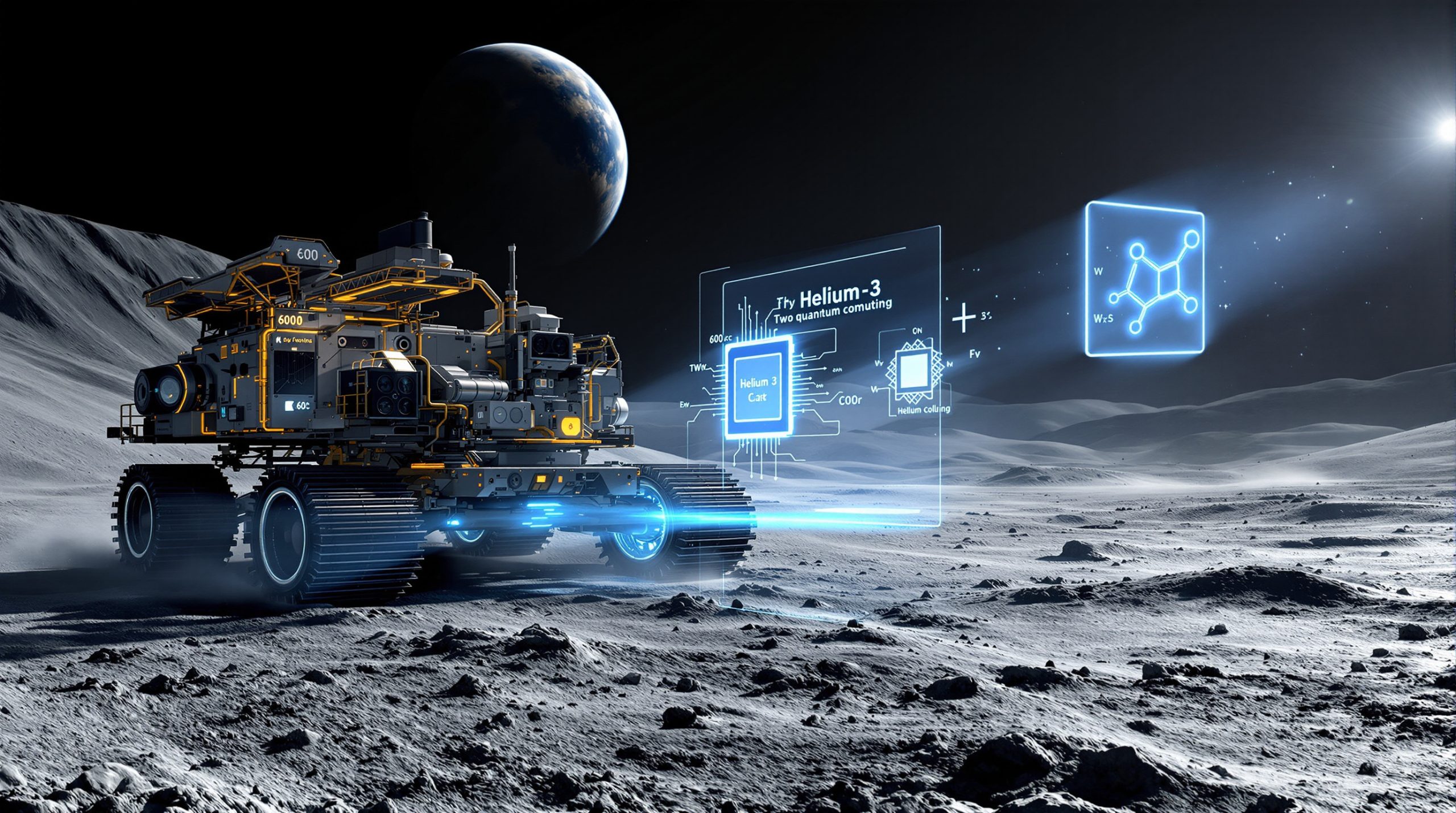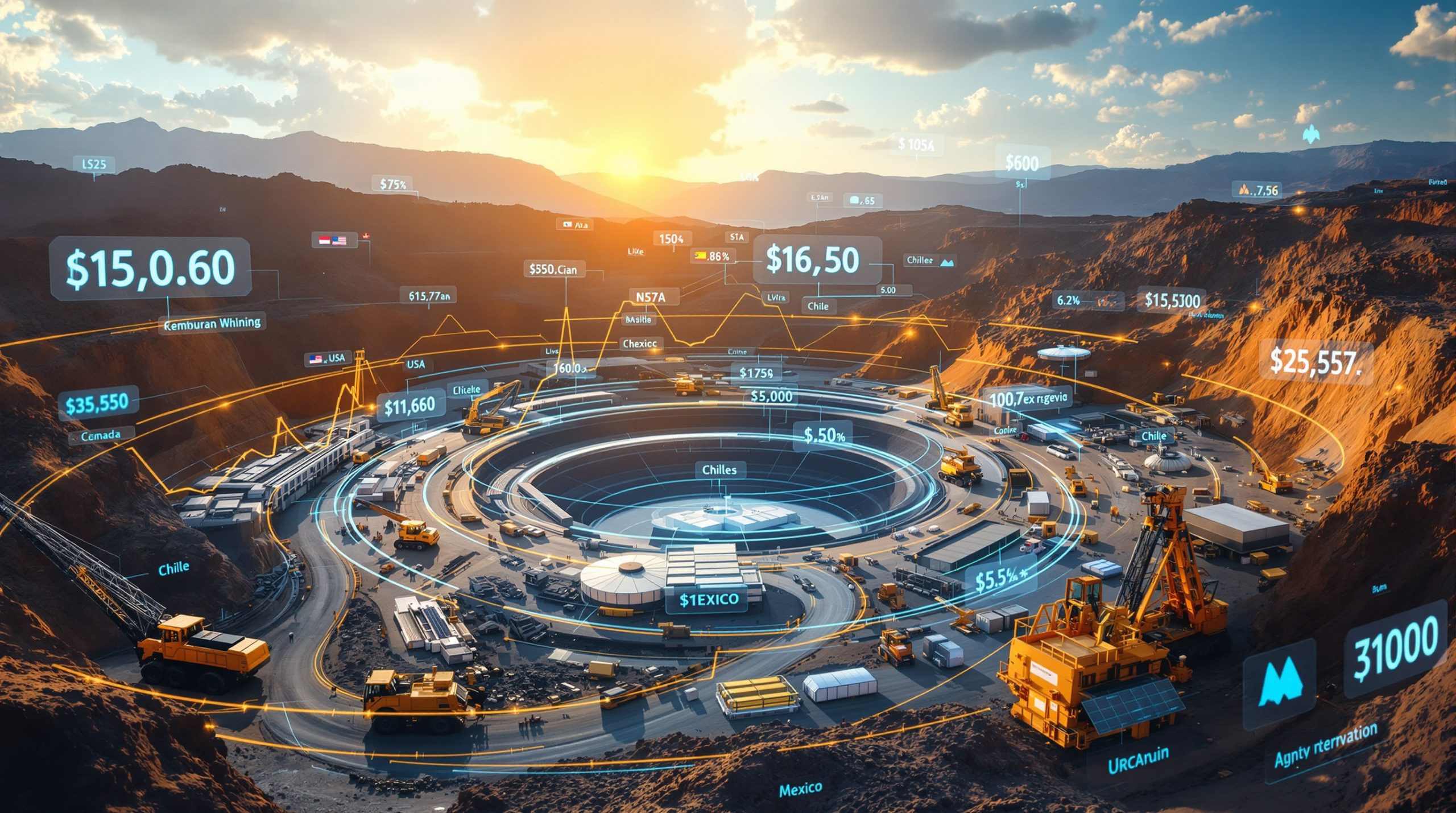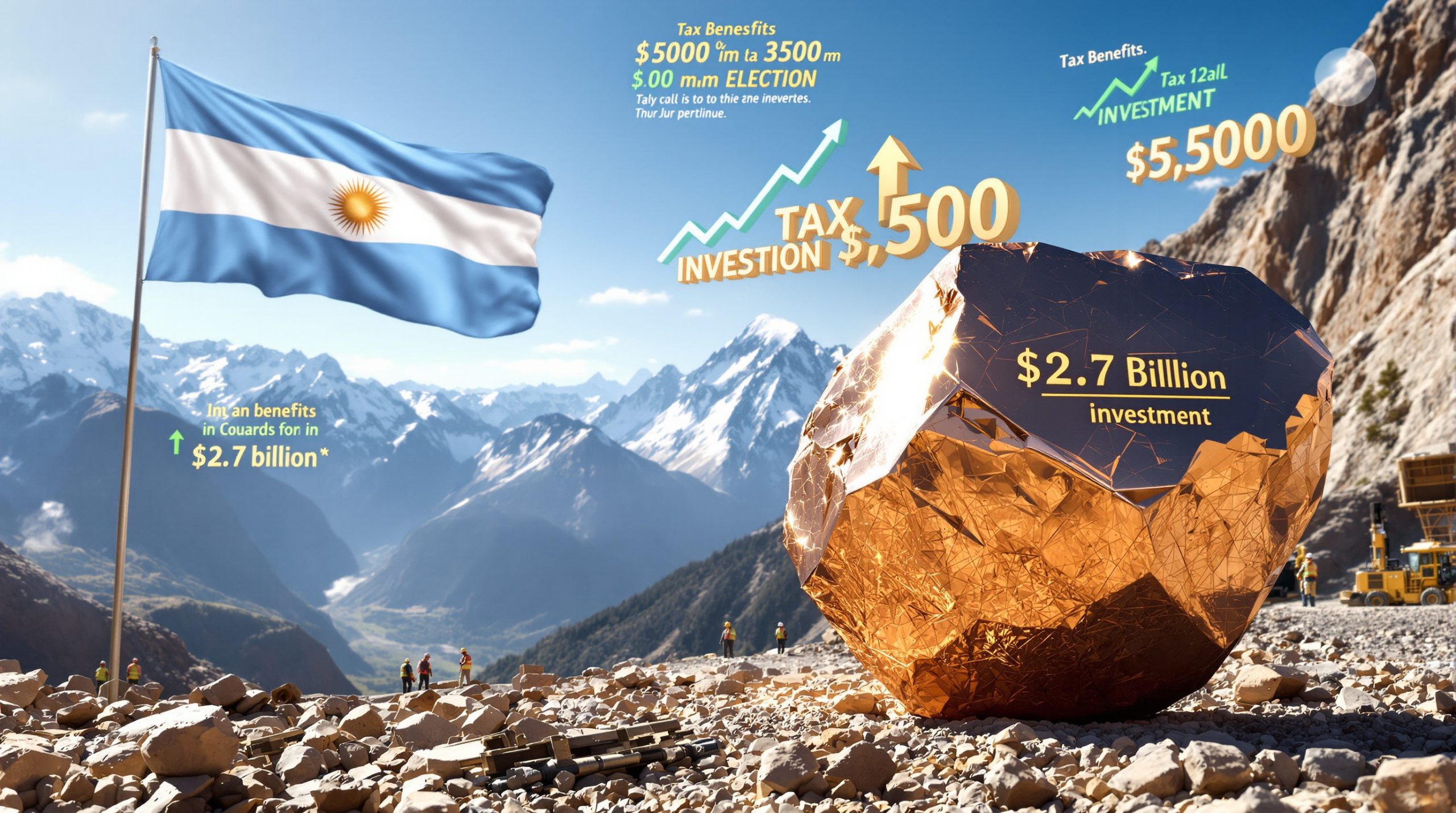What is Helium-3 and Why Mine it from the Moon?
Helium-3 (He-3) is a distinctive isotope of helium, composed of two protons and a single neutron. Unlike the more common helium-4, helium-3 is exceedingly scarce on Earth, but significant quantities are believed to be embedded in the Moon's regolith. Its non-radioactive nature opens possibilities for advanced technological applications such as quantum computing, high-precision medical imaging, and potentially revolutionary clean energy production via nuclear fusion. The concept of asteroid mining advances has increased interest in sourcing helium-3 from the moon as a complementary activity.
The Unique Properties of Helium-3
Helium-3 stands out due to several attributes:
- Non-radioactive and stable, making it safer to handle for technological applications.
- Enables ultra-low temperature environments required for sensitive equipment like quantum computers.
- Holds potential as a fuel for future nuclear fusion reactors, promising lower neutron emissions than traditional fuels.
The Moon's Helium-3 Deposits
Unlike Earth, shielded by its magnetic field, the Moon's surface has been continuously bombarded by solar winds for billions of years. These winds have embedded helium-3 into the upper layers of lunar soil. Scientific estimates indicate roughly 2 milligrams of helium-3 per metric ton of lunar regolith. Over time, this has led to a total lunar inventory projected between 1 and 5 million tons, although accessible quantities will depend on extraction advancements.
Applications Driving Demand
Helium-3 is drawing global attention due to its role in powering transformative industries:
- Quantum Computing: Helium-3 is essential for dilution refrigerators that reach millikelvin temperatures, enabling stable operations for qubits.
- Medical Diagnostics: Enhances diagnostic imaging such as MRI scans, potentially increasing the clarity of lung imaging and other soft tissue analysis.
- Scientific Research: Utilized for cryogenics in fundamental physics experiments where ultra-low temperatures are mandatory.
- Future Energy: If commercial helium-3 fusion proves feasible, the energy industry could be revolutionized by virtually waste-free, neutron-poor power generation.
How Would Lunar Helium-3 Mining Work?
Sourcing helium-3 from the Moon presents substantial technical and operational hurdles. The scarcity of helium-3 in regolith necessitates mining on a truly massive scale, coupled with reliable, energy-efficient extraction technology. The approaches being developed draw inspiration from mining industry evolution on Earth but adapted for the unique lunar environment.
Extraction Challenges and Technologies
To liberate helium-3 from lunar soil, large volumes must be heated beyond 600°C, releasing trapped gases for collection. Integrated mining concepts being developed include:
- Rugged mobile vehicles to harvest regolith at scale on the lunar surface.
- Self-contained thermal processing units that heat soil in modular batches.
- Advanced gas separation systems to distinguish minute helium-3 fractions from other volatiles.
- Highly specialized storage and transport containers to preserve extracted helium-3 throughout transit.
Required Processing Volumes
Due to helium-3's exceptionally low concentration, extracting useful quantities demands large-scale operations. Mining and processing around 500,000 tons of regolith is projected to yield only 1 kilogram of helium-3. To visualize: this is roughly equivalent to excavating and treating a parcel of the lunar surface about 20 acres in area and 3 meters deep—posing formidable operational and engineering challenges.
Prototype Development Progress
Several competitors have developed multi-stage prototype systems targeting scalable extraction. These systems typically follow this workflow:
- Excavation: Deploy robotic excavators to collect regolith efficiently.
- Sorting: Mechanically or sensor-based sorting to prioritize soil with higher helium-3 content.
- Heating: Thermal release of embedded helium and other gases by sustained high-temperature processing.
- Separation: Precision gas handling to isolate helium-3 from the other released elements for storage.
Who's Leading the Lunar Helium-3 Race?
The growing interest in sourcing helium-3 from the Moon has catalyzed a competitive race among private companies, each vying to establish the first sustainable lunar extraction operation. Modern technology, including AI in mining technology, is helping to make these ambitious projects more feasible.
Commercial Ventures and Partnerships
Interlune's Pioneering Efforts
Space mining company Interlune has emerged as a leader, unveiling mining machine prototypes capable of processing around 100 metric tons of regolith every hour. Their extraction system uses a four-stage methodology to maximize helium-3 recovery and has attracted considerable industry investment for scaling operations.
The Interlune-Bluefors Partnership
In a milestone commercial agreement, Interlune has secured a $300 million deal to supply Bluefors, a Finland-based quantum technology company, with up to 10,000 liters of lunar helium-3 annually between 2028 and 2037. This partnership will underpin Bluefors's production of advanced cryogenic systems vital to quantum computing, physics research, and medical diagnostics.
Timeline for Commercial Extraction
The leading commercialization roadmap includes:
- 2027: Scheduled demonstration mission to validate lunar mining hardware.
- 2028: Initial helium-3 deliveries to early customers such as Bluefors.
- 2029: Construction of a lunar pilot plant to continuously mine and process helium-3.
- 2030s: Transition to large-scale, regular extraction and shipment cycles.
What Technical Hurdles Must Be Overcome?
Sourcing helium-3 from the moon is a multi-front engineering challenge that encompasses transport logistics, energy requirements, and lunar automation.
Transportation Logistics
Moving mining equipment to the Moon and returning extracted helium-3 to Earth remains a high-cost, high-risk endeavor. Considerations include:
- Current lunar launch costs ranging from $1,500 to $10,000 per kilogram.
- Need for pressurized, temperature-stable containers to safely store and transport helium-3.
- Precision in flight trajectory planning for outbound and return missions, demanding advanced navigation and redundancy.
Energy Requirements
Operating on the Moon demands innovative solutions to power mining and processing systems:
- Extensive solar arrays are required to supply electricity during the lunar day.
- Efficient energy storage systems (like advanced batteries) must bridge operations through the lunar night, which lasts for approximately 14 Earth days.
- State-of-the-art thermal management to maintain processing temperatures in the Moon's fluctuating environment.
Autonomous Operations
Given the time delay in communication and inhospitable lunar conditions, extraction platforms and vehicles must function with minimal human intervention:
- Artificial intelligence to optimize operational decisions.
- Robust self-diagnostics and autonomous repair to minimize downtime.
- Redundant system design to preserve mission continuity in the event of component failure.
How Economically Viable is Lunar Helium-3 Mining?
Bringing lunar helium-3 to Earth is capital-intensive. Its value, however, is amplified by its scarcity and status as a potential enabler for breakthrough industries. The critical minerals energy sector recognizes helium-3 as a strategic resource.
| Factor | Estimated Costs/Benefits |
|---|---|
| Launch costs | $1-10 billion for initial infrastructure |
| Equipment development | $2-5 billion for bespoke lunar mining tech |
| Annual operational costs | $500 million – $1 billion |
| Potential annual revenue | $3-30 billion (application dependent) |
| Break-even timeline | 7-15 years post-extraction commencement |
Quantum Computing Market Driver
The quantum computing industry stands out as the primary early-stage market for lunar helium-3, given that high-performance quantum hardware demands reliable cryogenic cooling—an application where helium-3 is essential. Industry forecasts suggest the quantum computing market will be worth $65 billion by 2030, further heightening the strategic importance of consistent helium-3 supplies.
Long-term Value Proposition
Despite sizable initial investments, the broader payoffs could reshape multiple industries:
- Paving the way for lunar industrialization and broader space resource utilization.
- Accelerating advancements in space mining technologies applicable beyond the Moon.
- Creating an unprecedented, stable supply chain for a critical global resource.
- Unlocking a potential pivot point for global energy systems if fusion innovation becomes commercially viable.
Disclaimer: All financial figures and timelines represent current projections and are subject to significant change as technology and regulatory landscapes evolve.
What Legal and Regulatory Frameworks Apply?
The legal status of lunar resources falls into a gray area, as international space law matures to reflect new realities in off-Earth mining. Companies involved in modern mine planning are beginning to incorporate legal considerations for extraterrestrial operations.
The Outer Space Treaty and Moon Mining
The 1967 Outer Space Treaty restricts nations from claiming sovereignty over celestial bodies, but doesn't directly prohibit private or commercial extraction of lunar resources. This ambiguity generates uncertainty about ownership, profit rights, and stewardship responsibilities for lunar helium-3.
Emerging Space Mining Regulations
Recent regulatory shifts include:
- The U.S. Commercial Space Launch Competitiveness Act (2015) granting American enterprises rights over resources they recover from space.
- The Artemis Accords, which introduce basic protocols for lunar activities among signatory countries, encouraging transparency and conflict avoidance.
- The Moon Treaty, less widely accepted, proposes international management of lunar resources but lacks ratification from major spacefaring nations.
International Cooperation vs. Competition
Global approaches toward helium-3 mining diverge:
- A contingent of researchers and diplomats argue for collaborative frameworks to ensure equitable access.
- Some nations and companies are racing for first-mover advantage, seeking exclusive economic or technological benefits.
- Proposed multilateral systems aim to reconcile commercial incentivization with ethical stewardship.
How Would Lunar Mining Operations Impact the Moon?
Lunar mining may bring about irreversible changes—even in the absence of a traditional biosphere—prompting debates about planetary protection and scientific preservation.
Environmental Considerations
Although the Moon has no known ecosystem, mining will induce:
- Large-scale surface disruption, leaving visible excavation sites.
- Generation of dust clouds, which may interfere with both equipment and scientific instruments deployed elsewhere on the lunar surface.
- The creation of permanent scars in the lunar landscape, especially in high-activity zones.
Scientific Impact Assessment
Concerns from the scientific community focus on:
- Preserving lunar regions of unique geological and historical value.
- Preventing dust and gas contamination that might compromise sensitive astronomical research.
- Safeguarding pioneering landing sites and areas set aside for planetary science as heritage zones.
Sustainable Practices
Emerging best-practice recommendations for lunar mining operations include:
- Prioritizing extraction zones with lower research or heritage value.
- Implementing robust dust containment measures.
- Developing restoration protocols, even if only partial, for disturbed areas.
- Legally protecting sites identified as offering irreplaceable scientific data.
What Are the Alternatives to Lunar Helium-3?
Helium-3 alternatives are under active consideration, each their own set of technical and economic constraints.
Earth-Based Helium-3 Sources
Terrestrial helium-3 remains extremely rare, originating mainly as a byproduct of nuclear weapons maintenance and existing only in minuscule quantities in natural gas or the atmosphere. According to the European Space Agency, extraction from Earth's oceans is technically plausible but economically impractical, given even lower concentrations than lunar regolith.
Alternative Technologies
In response to supply limitations, research is accelerating on substitutes:
- High-temperature superconductors may one day alleviate the need for helium-3 in quantum computing.
- Alternative cooling cycles, especially those based on more abundant isotopes or advanced thermoelectric cooling, offer partial solutions.
- For fusion energy, deuterium-tritium cycles are more mature but introduce radioactive waste issues not associated with helium-3 fusion.
| Resource | Advantages | Disadvantages |
|---|---|---|
| Lunar Helium-3 | Abundant on Moon, clean fusion | Costly extraction and return |
| Terrestrial Helium-3 | No space launch needed | Tiny supply, high procurement costs |
| Deuterium-Tritium Fusion | Known technology, Earth-based | Radioactive byproducts, neutron radiation |
| Alternative Cooling Tech | Lower cost, viable today | May not meet extreme demands of next-gen tech |
What's the Timeline for Lunar Helium-3 Becoming a Reality?
Prospects for an operational lunar helium-3 supply chain are rapidly clarifying as private-sector milestones accumulate.
Near-Term Milestones (2025-2030)
- Deployment of demonstration missions to validate site selection and hardware operations.
- Initial extraction and return of helium-3 samples to Earth, primarily for proof-of-concept and process refinement.
- Construction of preliminary processing and logistics infrastructure on the Moon.
- Early commercial deliveries planned for customers in the quantum computing and research sectors.
Medium-Term Developments (2030-2040)
- Expansion of extraction operations and increased throughput.
- Commissioning of permanent, semi-autonomous lunar processing installations.
- Engineering advances in space logistics, lowering transport risks and costs.
- Parallel development of mining for other lunar resources such as water ice and metals.
Long-Term Vision (2040+)
- Potential for integrating helium-3–based fusion as a significant energy solution, contingent on fusion technology breakthroughs.
- Establishment of a sustainable lunar industrial base supporting Earth and deep-space ventures.
- The Moon becoming a critical node for resources supporting Mars and further space exploration.
- Ongoing transition toward a long-term, self-sustaining lunar resource ecosystem.
Frequently Asked Questions About Lunar Helium-3
How much helium-3 is on the Moon?
Estimated lunar helium-3 reserves total 1–5 million tons, with practical recoverable amounts being a subset due to technological and economic constraints.
Could helium-3 solve Earth's energy problems?
While possessing enormous potential as a clean fusion fuel, practical helium-3 fusion power remains experimental and distant. Initial supplies are most likely to serve specialized industrial and research needs rather than broad grid energy use.
How would helium-3 be transported back to Earth?
Plans involve utilizing scalable, pressurized modules within reentry vehicles—similar in concept to sample return missions but upgraded for much larger, more frequent deliveries.
What countries are pursuing lunar helium-3?
Active interests have been expressed by the United States, China, Russia, and the European Union. However, as of now, private enterprises have taken the lead in advancing extraction and commercialization capabilities.
How does helium-3 mining compare to other lunar resources?
Water ice and lunar metals may initially support habitation and manufacturing on the Moon itself, while helium-3—due to its unique properties and high per-unit value—remains a prime candidate for export to Earth, especially for quantum and energy applications.
Further Exploration:
Readers interested in the broader context of resource extraction both on Earth and beyond can find additional reporting and expert analysis through reputable mining publications, including CIM Magazine, covering the intersection of new technologies and the future of space mining.
Ready to Track the Next Major Mining Discovery?
Stay ahead of the market with Discovery Alert's proprietary Discovery IQ model, which instantly identifies significant ASX mineral discoveries and transforms complex data into actionable insights. Explore how historic discoveries have generated substantial returns by visiting our dedicated discoveries page and begin your 30-day free trial today.




